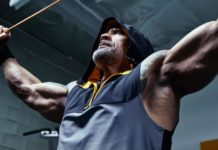TRAP WORKOUT -HARD GAINERS
Video
Description
?GRAB SOME MERCH:
?SUPPLEMENTS I USE:
?TRAIN WITH ME
?FOR THE LADIES:
USE CODE DAMIEN20 – 20% OFF
? My Instagram:
FULL WORKOUT:
SUPERSET
ABOVE THE KNEE RACK PULLS-3X 6
ABOVE THE HEAD PLATE RAISE-3X15
90-120 SECS REST BETWEEN SUPERSETS
SUPERSET
ABOVE THE KNEE RACK PULL TO SHRUG-3X10
ABOVE THE HEAD PLATE RAISE-3X10
90-120 SECS REST BETWEEN SUPERSETS
SUPERSET
FACE PULL -PAUSE REPS- 3 X 10
DUMBBELL SHRUGS-PAUSE AND SLOW NEGATIVES- 3 X 5
60-75 SECS REST
I hope all you traplords enjoy this workout and don’t forget to hit that thumbs up button 🙂
In human anatomy, the trapezius (/trəˈpiːzi.əs/) is one of two large superficial muscles that extend longitudinally from the occipital bone to the lower thoracic vertebrae and laterally to the spine of the scapula (shoulder blade). Its functions are to move the scapulae and support the arm.
The trapezius has three functional regions: the superior region (descending part), which supports the weight of the arm; the intermediate region (transverse part), which retracts the scapulae; and the inferior region (ascending part), which medially rotates and depresses the scapulae.
The trapezius muscle resembles a trapezium (trapezoid in American English), or diamond-shaped quadrilateral. The word “spinotrapezius” refers to the human trapezius, although it is not commonly used in modern texts. In other mammals, it refers to a portion of the analogous muscle.
The superior or upper (or descending) fibers of the trapezius originate from the spinous processes of C7, the external occipital protuberance, the medial third of the superior nuchal line of the occipital bone (both in the back of the head), and the ligamentum nuchae. From this origin they proceed downward and laterally to be inserted into the posterior border of the lateral third of the clavicle.
The middle fibers, or transverse of the trapezius arise from the spinous process of the seventh cervical (both in the back of the neck), and the spinous processes of the first, second, and third thoracic vertebrae. They are inserted into the medial margin of the acromion, and into the superior lip of the posterior border of the spine of the scapula.
The inferior or lower (or ascending) fibers of the trapezius arise from the spinous processes of the remaining thoracic vertebrae (T4–T12). From this origin they proceed upward and laterally to converge near the scapula and end in an aponeurosis, which glides over the smooth triangular surface on the medial end of the spine, to be inserted into a tubercle at the apex of this smooth triangular surface.
At its occipital origin, the trapezius is connected to the bone by a thin fibrous lamina, firmly adherent to the skin. The superficial and deep epimysia are continuous with an investing deep fascia that encircles the neck and also contains both sternocleidomastoid muscles.
At the middle, the muscle is connected to the spinous processes by a broad semi-elliptical aponeurosis, which reaches from the sixth cervical to the third thoracic vertebræ and forms, with that of the opposite muscle, a tendinous ellipse. The rest of the muscle arises by numerous short tendinous fibers.












